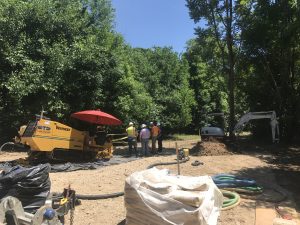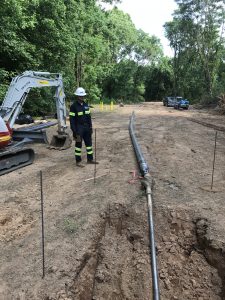Unusual Challenges Overcome in Georgia
With more than 20 years as a specialty directional drilling firm, DTD’s project managers have experienced, and overcome, a variety of geological, mechanical, and logistical challenges. From time to time, we have the opportunity to see new situations; as a result we often add new solutions to our collective experience. This was the case on a recent project in Georgia.
The project itself was straightforward. An existing groundwater extraction and treatment facility required expanded capacity to infiltrate treated groundwater back into the aquifer. A network of vertical wells was not keeping up with the flow, and a horizontal well was determined to be the best solution for long term distribution of the treated water across an extended zone. The design called for a 450 foot double-ended well, six-inches in diameter, with 200 feet of screen. The well, installed 32 feet deep in a sandy formation, would provide more than adequate capacity to infiltrate over 200 gpm of treated groundwater.
The first challenge was in accessing the site. The drill site itself has adequate space to park the equipment trailer, containing the Vermeer 24×40 drill rig, mud system, tooling and materials. Accessing the site from the road proved to be interesting, with sharp turns that could not be navigated by an over-the-road semi truck. DTD was able to acquire a short-wheelbase day cab, which allowed the crew to maneuver the equipment to the job site.

DTD operated a Vermeer 24×40 drill rig to install 450 feet of 6-inch HDPE for this treated-water infiltration well.
Once on site, the next challenge, was the unusual behavior of the walkover locating system. The system, a Digital Control Inc., Digi-Trak F5, is an advanced tracking system that pairs a surface-carried receiver to a bit-mounted transmitter unit, which enables the locating technician to follow the drill bit along the bore path in real time as the bore is advanced. The system allows the technician to choose from several frequencies to avoid interference from local sources. Although subject to interference at times from industrial motors, power lines, or other sources, these known sources of interference are generally observable and can be dealt with.
At the Augusta site, massive interference was noted. Even with the locating sonde situated within inches of the received on the ground surface, no usable signal was obtained. Ruling out equipment failure by obtaining new, working transmitters and receivers, a reliable signal could still not be obtained – however, the project manager determined that the issue lay somewhere on site, by driving off site a few hundred yards and attempting to calibrate equipment, which worked flawlessly off site.

Start of successful pullback of 6-inch well materials for the treated-water infiltration well, Augusta, GA.
Further investigation included an interview with the consultant’s site manager, who, in an “Aha!” moment, revealed that he had just installed a high-powered, wireless telemetry system to monitor the site’s many transducers and other control circuitry. Shutting off the telemetry instantly restored function to the walkover locating system, and drilling proceeded . The pilot bore was drilled within the next two days and the well was installed shortly thereafter.
Prior to starting any project, DTD completes a pre-construction teleconference with our clients, where we discuss site logistics, drilling waste generation and disposal, etc. As telemetry systems become less expensive and more simplified to install and operate, we anticipate seeing more of these installations, particularly on sites with extensive monitoring programs. Prominent in future discussions is a query about on-site telemetry!